Environmental Subsidies and Transfers in Ireland 2021
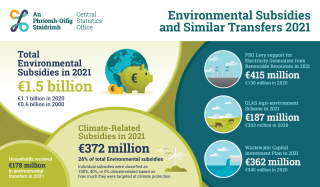
According to the most recent data from the CSO, environmental subsidies and similar transfers in Ireland were €1.5 billion in 2021, which was an increase of €327 million, or 29 per cent, compared with 2020. In 2021, 58 per cent (€836 million) of total environmental transfers went to environmental protection activities such as wastewater management, protection of biodiversity, and protection of air and climate, while 42 per cent, or €617 million, went to resource management activities such as production of energy from renewable resources, heat/energy saving, and management of forest resources. Households received €178 million in environmental transfers in 2021.
Environmental Subsidies and Similar Transfers 2021 – main findings
Climate related subsidies reached €372 million, a 50 per cent increase on 2020 and their highest value since 2000. This is mainly due to an increased level of Public Service Obligation (PSO) Levy support to electricity generation from renewable sources, which rose from €130 million in 2020 to €415 million in 2021. The schemes paying the highest amount in subsidies in 2021 were the PSO Levy support to electricity generation from renewable sources at €415 million, funding of €362 million for wastewater infrastructure under the Capital Investment Plan, and Green Low-carbon Agri-environment Scheme (GLAS) payments of €187 million.
Beneficiary, Type of Transfer, and Source of Funding
Corporations received the largest amount of environmental transfers in 2021 at €760 million. General government received €497 million in environmental transfers in 2021, and households received €178 million. Transfers to corporations mainly went to the Agriculture, Forestry and Fishing sectors (€294 million) and the Electricity, Gas and Air sector (€418 million).
Capital transfers such as investment grants made up 50% of environmental transfers paid in 2021 while current transfers were 49% of the total and tax abatements such as Vehicle Registration Tax relief on electric vehicles accounted for the remainder.
The two most significant sources of funding for environmental transfers in 2021 were the Department of Housing, Local Government and Heritage which provided funding to Irish Water (since Uisce Éireann) and local authorities for environmental protection activities, and the PSO Levy support to electricity generation from renewable sources.
Environmental Subsidies and Similar Transfers by Environmental Purpose
Figure 1 shows the value in current prices of environmental subsidies and similar transfers for 2000-2021 with a breakdown by environmental protection and resource management activities. Total environmental transfers were at €632.8m in 2000 and reached their highest in 2021 at €1.5 billion in value.
Environmental protection transfers peaked in 2008, decreased sharply between 2010 and 2013 and rose in each year from 2016 to 2021. Resource management transfers showed an overall increasing trend from 2000 to 2018, fell in 2019 and 2020, then rose to the highest value in 2021 at €617 million.
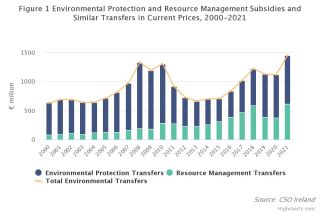
Climate-related Subsidies and Similar Transfers
The value in current prices of climate-related subsidies and similar transfers for 2000-2021. In 2000, transfers for climate protection were €2 million in current prices. This rose to €9 million in 2005, €81 million in 2010, €105 million in 2015 and €247 million in 2020. The decrease after 2018 was due to the reduced PSO Levy support to electricity generation from renewable sources in 2019 and 2020, compared with 2018. Climate-related subsidies reached their highest value in current prices since 2000 at €372 million in 2021, a 50 per cent increase on 2020.
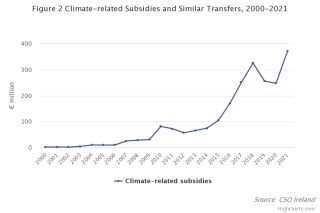
Environmental Protection Transfers
Figure 3 shows the distribution of environmental protection transfers by domain from 2000 to 2021. In 2021, wastewater management received the largest share of transfers, primarily through the funding of Irish Water's Capital Investment Plan by the Department of Housing, Local Government and Heritage (see Table 2.2). Protection of biodiversity and landscapes received the next largest share of the total in 2021. The largest biodiversity-related scheme in 2021 was the Green, Low-emissions, Agri-environment Scheme (GLAS), which was co-funded by the EU and the Department of Agriculture, Food and the Marine (see Tables 2.1 and 2.6).
Transfers targeted at the protection of ambient air and climate received 10% of the total in 2020. The increase in funding for this environmental domain from 2014 onwards was partly due to increases in electric vehicle grants administered by the SEAI and Vehicle Registration Tax (VRT) relief on electric vehicles. A concern looking at these figures is the very limited amount of funding allocated for research development for environmental protection. In light of our 2030 targets this allocation will likely have to increase.
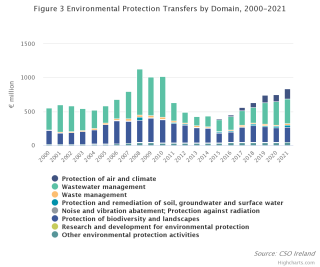
Resource Management Transfers
Resource management transfers in 2021 were mainly aimed at production of energy from renewable sources (€431 million), heat/energy saving and management (€111 million), and management of forest resources (€58 million). The support to electricity generation from renewable sources was mainly from funds collected through the PSO Levy on electricity consumers. A number of grant schemes supported energy-saving measures, primarily programmes run by the Sustainable Energy Authority of Ireland (SEAI) and funding for energy efficiency retro-fitting of local authority housing. The Afforestation Scheme funded by the Department of Agriculture, Food and the Marine was the source of most of the funding provided for management of forest resources.
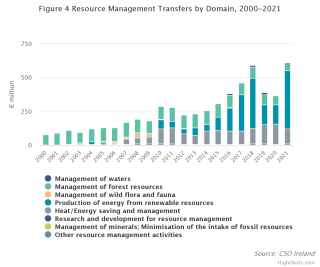
Environmental Subsidies and Similar Transfers by Beneficiary
Figure 5 shows how environmental subsidies and similar transfers were distributed to different sectors of the economy from 2000 to 2021. Corporations received the highest level of transfers in 2021 at €760 million. General government received €497 million in environmental transfers in 2021, households received €178 million, non-profit institutions serving households received €11 million, and €7 million went to international organisations.
Transfers to corporations mainly went to the agriculture, forestry and fishing sectors (€294 million) and the electricity, gas and air sector (€418 million). Environmental transfers to general government were mainly made to local authorities, Uisce Éireann (formerly Irish Water) and the Environmental Protection Agency. In 2021, most household grants were for the purpose of carrying out energy efficiency measures in their homes or purchasing electric vehicles.
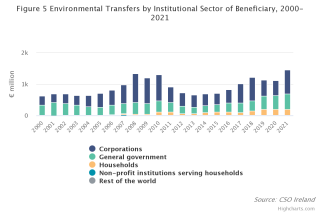
Environmental Subsidies and Similar Transfers by Type of Transfer
From 2019 to 2021 capital transfers exceeded current transfers, meaning that more funding was used for investment than to support day-to-day operating expenditure. Capital transfers were 49.6 per cent of total environmental subsidies and similar transfers in 2021, while current transfers were 48.9 per cent and tax abatements (such as VRT relief on electric vehicles) were 1.5 per cent.
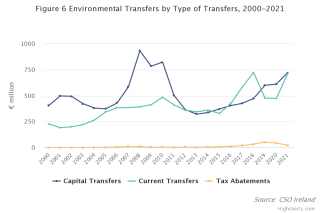
Environmental Subsidies and Similar Transfers by Source of Funding
In 2021, environmental transfers were predominantly funded nationally (90%) while the remaining 10% came from the EU. The largest contribution was from the Department of Housing, Local Government and Heritage, which provided €452 million in environmental subsidies and similar transfers, including funding to Irish Water for wastewater infrastructure under the Capital Investment Plan.
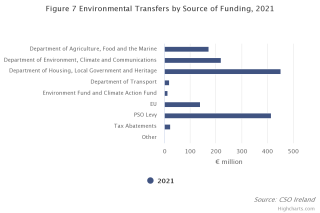
Social Justice Ireland view
In 2020, Government raised €2.8 billion in energy taxes, of this just €0.4 billion was spent on environmental subsidies related to energy and emissions, while fossil fuel subsidies were €2.2 billion. Taxation policy must be aligned with our national climate targets. The 2021 figures from the CSO show revenue for fossil fuel subsidies is still substantially higher than environmental subsidies an issue that has to be addressed.
Subsidies are an element of the environmental tax code that should be reviewed. By eliminating harmful environmental subsidies mean government will have a wider fiscal space available to it in terms of climate policy and taxation. In terms of overall public expenditure, systematic reviews should be carried out and published on the sustainability impacts and implications of all public subsidies and other relevant public expenditure and tax differentials. Subsidies which encourage activity that is damaging to natural, environmental and social resources should be abolished.
Environmental taxation, enforcing the polluter pays principle, and encouraging waste prevention can help to decouple growth from the use of resources and support the shift towards a low carbon economy. Incorporating social and environmental costs in regulating and pricing both goods and services, combined with promoting those goods and services which are sustainable, should become part of sustainable development policy.